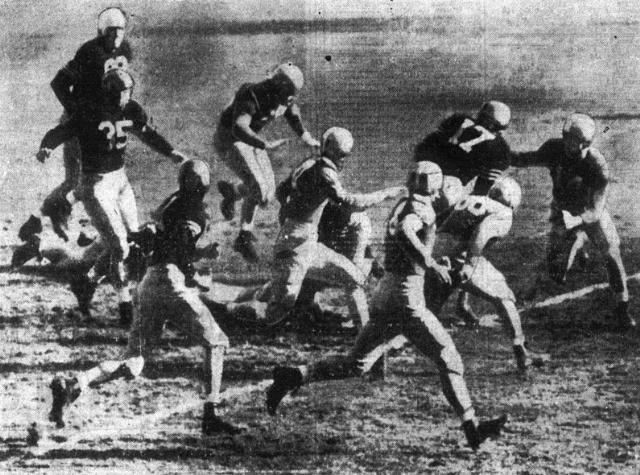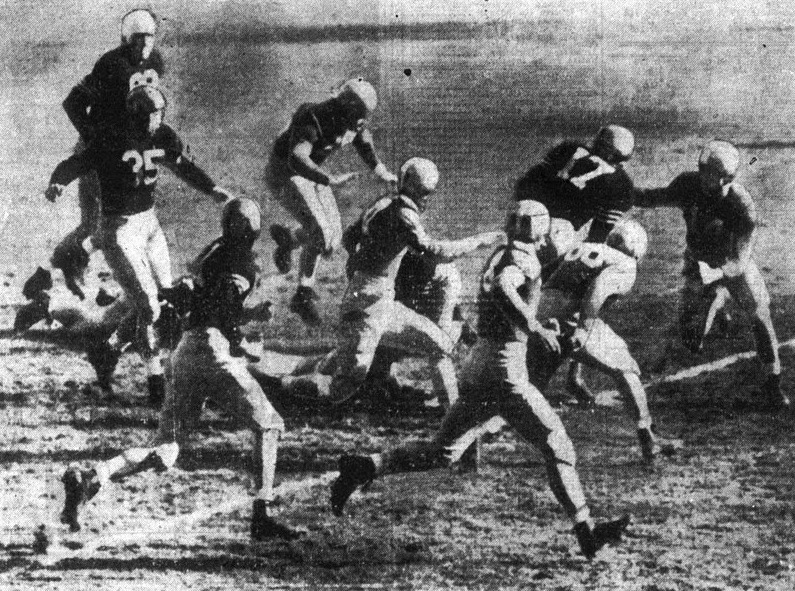

Public domain
For the first time since the 1940s, these two teams are once again league powerhouses as they face off against each other.Army and Notre Dame will meet for the 52nd time in a rivalry, with both vying for the national title. This matchup has not been so important since the 1940s when the schools were simultaneous powerhouses.
Sure, in 1958, Number 3 Army did meet Number 4 Notre Dame, but that was in South Bend, Indiana, and it was just the third game of the season. Army prevailed 14-2 and would finish third in the polls, finishing 8-01 the only blemish, a tie with Pitt. That Army squad was led by that season’s Heisman Trophy winner, running back Pete Dawkins.
But since then, Army hasn’t come close to sniffing a championship, let alone a title run. That’s why the game on Saturday night, a primetime affair for the entire nation to watch and enjoy, will undoubtedly recall a time when college football was simpler and a little less about the business end of the sport.
What might evoke such feelings in ardent, passionate college football fans while inviting new fans to be entertained and become new devotees to the college game? Simple: History.
<img alt captext="Public domain” src=”https://conservativenewsbriefing.com/wp-content/uploads/2024/11/the-army-notre-dame-clash-has-some-incredible-sports-history-behind-it.jpg” width=”500″>
Image: The Army-Notre Dame opening kickoff in 1946. Public domain.
The game will be played in the Bronx—specifically, Yankee Stadium—a venue these institutions have often used to wage some of their more memorable games. (It’s being played in “new” Yankee Stadium, but the principle is the same.)
This game had already been set as a prime-time event for Saturday night, but now, with the schools both in the Top Twenty, the hype and hope for the game to be a classic have grown exponentially.
Notre Dame, as usual, comes into the game expecting to play for the national title by being a participant in the newly expanded college football playoffs.
Army, still cobbling a football roster of recruiting through employing the “traditional” rules and academic/athletic eligibility, is limited because it cannot offer the new options the NCAA allows. These options include NIL (Name, Image, and Likeness) money, the transfer portal, and extended years of eligibility, all of which are incentives for scholar-athletes to matriculate at Division One institutions of higher learning in return for spilling blood and sweat on the gridiron.
Despite being boxed in, Army is still trying to play “big time” football, competing as a new member of the American Athletic Conference (AAC), a football conference made up of teams that the academic Mega Conferences from coast to coast have cast aside, ignored, snubbed, and even ostracized, kind of like the toys of Misfit Island. like the toys on the Island of Misfit Toys.
These “leagues on steroids” have dominated the entire landmass, monopolizing all the television markets, continental time zones, media, and money. Although, technically, Notre Dame has still maintained its “Independent” status, it’s aligned its other sports with the big leagues in the Atlantic Coast Conference (ACC) while the football team plays a portion of its schedule against ACC members.
Yet, back in the day, Army was king, and its battles with Notre Dame, especially in the Bronx, were historic. That’s why this game has taken on importance and a bit of nostalgia.
In the three consecutive years of 1944, 1945, and 1946, Army was a juggernaut, a behemoth, the Leviathan of college football. It destroyed everyone in sight. It wasn’t just wiping out the weak teams that today’s powerhouse teams use as their paid sacrificial lambs, but real opponents.
Under the guidance of their greatest coach, Errol Red Blaik, The Black Knights of the Hudson reduced opponents to a pulp, pounding, rolling, and spitting out rivals with machinelike coldness and efficiency. They defeated 14 schools, three military teams, and 11 ranked opponents. Army’s defense, which was not as acclaimed as its offense, was cobra-like on rival offenses. Army recorded 13 shutouts and limited teams to a total of 161 points for all the other teams put together—fewer than six points per game in their 28 contests.
In Army’s three-year run, the offense churned out yardage in large chunks and tallied points at will, averaging over 40 points a game. They pulverized their rivals.
The Cadet offense fashioned not one but two Heisman Trophy players in their backfield, each shredding defenses and scoring touchdowns in bunches. Their names are legendary in college football history: Felix “Doc” Blanchard and Glen Davis, aka “Mr. Inside and Mr. Outside.”
Notre Dame was no chump during this three-year period, compiling a 23-4-2 mark with a 7-2-2 mark against ranked opponents. It finished in the Top Ten all three years, copping the national title in 1946.
But how good was Army? Really good.
While Notre Dame averaged 27.5 points per game, it never crossed the goal line in its three encounters with Army, being outscored 107-0 as Army won consecutive national titles.
The Irish limited their opponents to 9.1 points per game with 13 shutouts. But of the 264 points given up by the Irish defense in that span, Army was responsible for 40.5% of them.
Interestingly and ironically, Notre Dame’s and Army’s final match in 1946, neither the number two ranked Irish nor the number one and defending champs Black Knights scored, ending in a 0-0 tie. Yet, the scoreless draw would serve as a win for Notre Dame because, by season’s end, pollsters would slide the Irish into the number slot ahead of Army. The rationale: Army beat their bitter rival Navy by three points while Notre Dame manhandled its California rival USC.
However, those days of Army dominance have disappeared, more than likely never to return, mostly for economic reasons. The NFL is a billion-dollar corporation with franchises in every corner of the country. Millions of dollars in potential earnings are indeed hard to pass up, especially when the alternative is surrendering years of service in the military after graduation.
NIL deals provide large cash incentives for today’s athletes, even ones not talented enough to make it at the professional level, to sign with good ol’ State instead of making a nine-year commitment to the Army. Yes, the rules for postgraduate service have been loosened, but most Cadets realize their last collegiate game is their last football game, and their commitment to the military begins.
For now, enjoy the prime-time game played, albeit in a new venue, but an environment that could just be haunted by the spirits of the Black Knights of the Hudson’s previous glory.
<img alt captext="Will O’Toole” src=”https://conservativenewsbriefing.com/wp-content/uploads/2024/11/the-army-notre-dame-clash-has-some-incredible-sports-history-behind-it-1.jpg”>
Image by Will O’Toole, whose other work can be found at OToons Cartoons.






